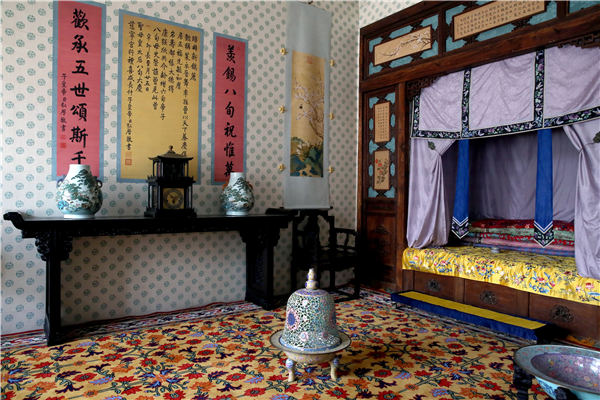
From the luxurious bedrooms of the mothers of kings to personal worship areas filled with Buddha statures, the Palace Museum is showing us a different side of imperial China. Deng Zhangyu reports.
Visitors to the Forbidden City can now get a glimpse of how the mothers of emperors lived. They can view luxuriously decorated bedrooms and a private worship hall among other treasures of the Palace Museum in Beijing.
The Cining Palace complex in the western part of the Forbidden City was opened on Saturday to the outside world for the first time as part of the celebrations of the 90th anniversary of the museum.
To celebrate the birthday, more than 1,000 treasures from the royal families were displayed in eight shows in four newly opened areas: the Cining Palace complex for emperors' mothers, wings of the Meridian Gate, East Prosperity Gate and the Baoyun Building, a warehouse built in 1914 to store treasures.
Shan Jixiang, museum director, says most of the precious items on display are being shown for the first time. He says the shows, which took three years to prepare, offer a rare opportunity for visitors to learn more about the emperors and their families, such as the women's residences that are often featured in films.
"There are even ghost stories about the women's residences in the Forbidden City. Now visitors can see that the stories are just tales," says Shan.
One of areas opened up is the Shoukang Palace, which forms a part of the Cining Palace complex.
From the luxurious bedrooms of the mothers of kings to personal worship areas filled with Buddha statures, the Palace Museum is showing us a different side of imperial China. Deng Zhangyu reports.
Visitors to the Forbidden City can now get a glimpse of how the mothers of emperors lived. They can view luxuriously decorated bedrooms and a private worship hall among other treasures of the Palace Museum in Beijing.
The Cining Palace complex in the western part of the Forbidden City was opened on Saturday to the outside world for the first time as part of the celebrations of the 90th anniversary of the museum.
To celebrate the birthday, more than 1,000 treasures from the royal families were displayed in eight shows in four newly opened areas: the Cining Palace complex for emperors' mothers, wings of the Meridian Gate, East Prosperity Gate and the Baoyun Building, a warehouse built in 1914 to store treasures.
Shan Jixiang, museum director, says most of the precious items on display are being shown for the first time. He says the shows, which took three years to prepare, offer a rare opportunity for visitors to learn more about the emperors and their families, such as the women's residences that are often featured in films.
"There are even ghost stories about the women's residences in the Forbidden City. Now visitors can see that the stories are just tales," says Shan.
One of areas opened up is the Shoukang Palace, which forms a part of the Cining Palace complex.
The birthdays of the emperors and their mothers were national celebrations.
Painting of the 60th Birthday Celebration of Emperor Kangxi is on show for the first time.
The 40-meter-long painting depicts a street view of 18,000 people celebrating the emperor's birthday. The show also includes a separate room displaying birthday gifts given to the emperors. One of the gifts on display is a gilded rifle presented by Lord Macartney, the envoy sent by George III of Britain in 1793.
"We have found lots of birthday gifts sent by foreign countries to emperors of the Qing Dynasty (1644-1911) in our warehouses. The rifle from Britain is one for which we have the most details," says Ren Wanping, director of the antiques department at the museum.
Ren says that other than the rifle, there are lots of interesting things that were sent by Britain which was then in the midst of the Industrial Revolution.
Among the gifts are also screens with poems written by emperors' sons and grandsons, a very rare chance to see the handwriting of sons and grandsons of Emperor Kangxi (1662-1722). The reign of Emperor Kangxi of the Qing Dynasty marked the start of a relatively prosperous period for the dynasty. His son and grandson were also able rulers.
Besides shows on the world of the royal women and imperial birthdays, visitors can also see shows featuring old houses in the Forbidden City.
The new treats at the Forbidden City have begun attracting large crowds. Long lines outside the palaces are a common scene.
"It could mean a long wait to see a show," says Xiong Ning, who visited the Palace Museum on Sunday.





